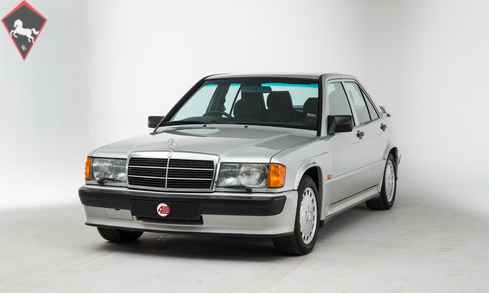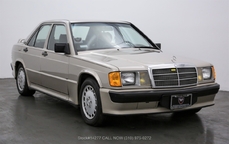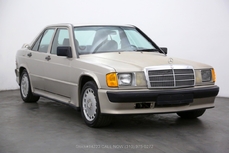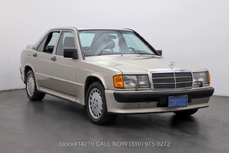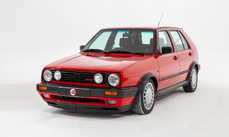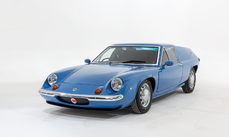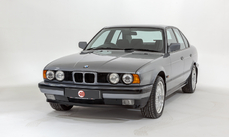Mercedes-Benz 190 2.3-16 2.5-16 Cosworth 1989
General description :
Model History
The Mercedes Benz 190 model name was first introduced in 1953 and has taken many different disguises until its final replacement in the form of the C series in 1993. The final incarnation of the 190 was the W201 chassis. £600 million was rumoured to have been spent developing the model, enough to have seriously damaged Mercedes-Benz reputation and financial position had the car been a failure. Luckily this was not the case and Mercedes went on to sell approximately 1.8 million units worldwide.
The introduction of the special edition 2.3-16v model in 1983 came from Mercedes-Benz's desire to re-enter motorsport with a direct factory team after their retirement following the tragic events at the 1955 Le Mans race. Enlisting the help of the British engineering firm Cosworth, Mercedes had plans to take the 190E to the rally circuit, however the project suddenly became unrealistic when Audi released the turbo charged, four-wheel drive Quattro, in effect beating the 190E before the race had even started! Mercedes not wanting to lose their financial investment in development ditched plans for the rally circuit and turned their attention to the German touring car championship.
The Cosworth engine was based on the 2.3-litre 8-valve already fitted to models in the range. Cosworth added an alloy head with twin overhead cams and 4 valves per cylinder boosting power to 185bhp and 174lb-ft. The car proved incredibly robust, with three cars only cosmetically altered completing a 50,000 km endurance test at the Nardo testing facility averaging 154.06mph and earning Mercedes three world records and nine international endurance records.
A larger 2.5-litre engine replaced the 2.3 in 1988. The 2.5 utilised a double valve timing chain to fix the problem of the single chains snapping on the 2.3. The increase in capacity took power to 204bhp in the non-catalyst car.
Both the 2.3 and 2.5 16v Cosworths featured a body kit that reduced the drag coefficient to 0.32 one of the lowest figures for a four door saloon at the time. The steering wheel was smaller and steering ratio quicker than other 190Es. The Getrag 5-speed manual ‘dog-leg' box was standard, with the option of an automatic box along with a full leather interior. A limited slip differential was standard on the 2.3-16v, with the option of Mercedes ASD system that was standard fit on the 2.5-16v. ASD is an electronic system that hydraulically controls the amount of lock in the diff ranging from the standard 15% lock right up to 100%!
Equipment
Electric tilt and slide sunroof, Electric windows front and rear, Heated rear window, 15-inch alloy wheels, Stainless exhaust with factory-style outlets, Anti-lock braking system (ABS), Automatic locking differential (ASD), Electrically operated passenger door mirror, First aid kit, Five-speed manual (dogleg) transmission, Front seat height adjusters, Headlamp wash/wipe, Heated door mirrors, Leather covered steering wheel and gearshift, Lockable glove box, Remote central locking, Power assisted steering, Rear centre armrest, Rear head restraints, Self-levelling rear suspension, Tinted glass, Blaupunkt head unit with Bluetooth, Spare wheel, Jack, Spare key.
Exterior
The Cosworth is finished in timeless Astral Silver. Under the glare of our studio lighting the bodywork shows a beautiful deep shine, boasting a recent full repaint to an excellent standard. Looking closely all the panels are straight and free from any dings. The gleaming paint shows no signs of bubbling whatsoever, and both bumpers are in great order with no unsightly scuffs to report.
With the intention of keeping it forever the previous owner set out to make the car perfect, spending around £10k in the process. The bodykit was stripped and any hints of corrosion were taken care of. The front wings were replaced with brand new panels from Mercedes and internally coated with stone chip guard. The entire body and body kit were then professional repainted before the car was fully waxoyled underneath. The door cavities were also sprayed with wax as further preventive treatment. The entire refresh is well documented with photographs and invoices.
Interior
Opening the door to the Cosworth you are presented with crisp half leatherette/chequered cloth seats. The upholstery remains in excellent condition with only the light wrinkling to the bolsters. The cloth inserts are also in fantastic condition, still feeling firm with no wear or sagging to report. With only the lightest of use over the years the rear seats are in particularly notable condition.
Cast an eye over the dashboard and you'll notice a deep texture remains, unworn with no cracks or sun damage to be found. Other details, such as the centre console and lacquered wood trim are in perfect condition, with the steering wheel and switchgear showing only minimal wear; the only negative to report being some wear to the armrest on the driver’s door card. Elsewhere, the carpets are protected in all footwells with black Mercedes overmats, and the boot area is clean and tidy, free from any damp, and still housing the spare wheel and jack.
ENGINE & TRANSMISSION
Often these cars suffer from cold start problems but on this example the 2.5-litre engine fires into life first turn of the key and ticks over smoothly. This 190E is equipped with the desirable five-speed dogleg gearbox. On test the car pulls smoothly through the gears as it should, handling the engine's power perfectly. A stainless exhaust has been fitted in recent years, which sounds great without being too boomy at higher revs; original-style exhaust tips mean the factory appearance is preserved.
Upon arrival at 4 Star the car was found to have low compression in two cylinders. The cylinder head was then sent away for a complete overhaul before being re-fitted to the car with all new gaskets and seals. The process of rebuilding the top end included precision laser welding to the head, a new timing chain tensioner, and lubrication service, all costing in the region of £2,500.
WHEELS, TYRES & BRAKES
Filling the wheel arches are the original 15-inch Mercedes alloys, all in super condition with only very minor marking to a couple worthy of note. The wheels are shod in a recent set of Continental tyres with ample tread remaining. On test the brakes feel capable and strong, pulling the car up smoothly in a straight line.
History File
The Mercedes was first registered in August 1989. The supplying dealer, Maloney & Rhodes Ltd, sold it to the first keeper who owned the car for seven and a half years, up until 47k miles. It was then sold through Portfield Mercedes-Benz in Chichester to the second keeper, who pampered the car for the next 13 years.
No less than twenty-three stamps can be found in the original service booklet, with all additional maintenance and service work detailed in the raft of accompanying invoices. In May 2018 the car received a thorough underside overhaul to include new diff oil seals, new rear suspension arms, and new gearshift bushes, totaling in excess of £1,300. Since arriving at 4 Star we have personally around £2,500 inspecting the car and subsequently having a top end rebuild carried out.
We are delighted to offer this magnificent example for sale once again, having sold it to the current owner, the keeper before him, and the keeper before him! In the history file every MOT certificate has been kept since 1997, as well as many invoices for service work and replacement parts also dating back to 1997. The leather Mercedes document holder is still present with all the dealer-supplied owner's manuals and booklets. An original sales brochure is also included. The complete service history is detailed below:
21/08/1989 at 1,378 miles16/05/1990 at 7,514 miles27/01/1992 at 20,200 miles27/07/1992 at 22,607 miles13/07/1993 at 26,802 miles18/02/1994 at 31,845 miles28/07/1994 at 35,715 miles17/05/1995 at 40,019 miles09/01/1996 at 43,430 miles07/02/1997 at 47,753 miles18/08/1997 at 52,834 miles16/02/1998 at 58,809 miles21/07/1998 at 65,426 miles26/02/1999 at 71,884 miles19/01/2000 at 75,451 miles09/04/2001 at 81,567 miles19/06/2002 at 87,864 miles07/11/2003 at 93,095 miles18/09/2010 at 99,609 miles16/06/2011 at 103,939 miles29/06/2012 at 111,525 miles11/06/2013 at 114,347 miles11/12/2014 at 119,799 miles16/03/2016 at 132,900 miles26/10/2017 at 145,060 miles16/09/2019 at 147,011 miles16/01/2020 at 147,260 miles – top end rebuild
http://www.4starclassics.com/for-sale/mercedes-190e-2-5-16-cosworth-for-sale/
1989 Mercedes-Benz 190 2.3-16 2.5-16 Cosworth is listed sold on ClassicDigest in Kingsley by 4 Star Classics for £19995.
Car Facts
Car type : Car Make : Mercedes-Benz Model : 190 2.3-16 Model Version : 2.5-16 Cosworth Engine size : 2.5 Model Year : 1989 Sub type : Van Location : Hampshire
Sold
Seller Information
Sold
People who viewed this Mercedes-Benz 190 2.3-16 also viewed similar Mercedes-Benz listed at ClassicDigest
Other cars listed for sale by this dealer
About Mercedes-Benz
In the annals of automotive history, the journey of Mercedes-Benz is a tale that unfolds with the ingenuity of its founding pioneers. In the year 1886, Karl Benz crafted the Benz Patent Motorwagen, a creation that would go down in history as the world's inaugural automobile. Unbeknownst to him, this moment marked the genesis of what would evolve into the most illustrious premium car manufacturer globally. The financial underpinning of this pioneering venture, interestingly, was provided by Karl Benz's wife, Bertha Benz, demonstrating a remarkable partnership that would set the tone for Mercedes-Benz's legacy.A parallel narrative emerged not far away, as Daimler-Motoren-Gesellschaft, founded by Gottlieb Daimler and Wilhelm Maybach, entered the scene. In 1901, they unveiled their automobile under the now-famous moniker "Mercedes," meaning "godsend" in Spanish. This name was bestowed upon the car at the behest of Emil Jellinek's daughter, the distributor for Daimler-Motoren-Gesellschaft. The wheels of innovation were set in motion.
Fast forward to 1926, a pivotal year that witnessed the merger of Daimler with Benz & Cie., culminating in the birth of Daimler-Benz. The amalgamation saw the adoption of "Mercedes-Benz" as the distinguished trademark for their automobiles, fusing the legacies of two visionary entities into one.
Contrary to perceptions of conservatism, the trajectory of Daimler-Benz unfolds as a chronicle of industry firsts. From the introduction of the honeycomb radiator to the float carburetor, and the pioneering implementation of four-wheel brakes in 1924, Daimler-Benz consistently pushed the boundaries of automotive innovation. The diesel-powered Mercedes-Benz 260 D in 1936 marked the inception of diesel engines in passenger cars. The iconic Mercedes-Benz 300SL Gullwing made history as the first car with direct fuel injection, albeit the Gutbrod's tiny 2-stroke engine can claim precedence.
Safety innovations became a hallmark, with Béla Barényi's patented safety cell design in the "Ponton"-models in 1951, featuring front and rear crumple zones. The W116 450SEL 6.9 saw the introduction of the Anti-Lock Brake system (ABS), another pioneering safety feature. From the first production airbags and beyond, the legacy of "firsts" continued to be etched into the fabric of Daimler-Benz.
Over its centennial journey, Mercedes-Benz has not merely produced cars but has sculpted automotive icons. The SSKL, 710 SSK Trossi Roadster, 770K Grosser, 540K Spezial Roadster, 300SL Gullwing, w100 600 Pullman, w111 280SE 3.5 Flachkühler, w113 230SL Pagoda, w109 300 SEL 6.3, and w201 2.3-16 Cosworth stand testament to the brand's commitment to engineering excellence.
The roaring Silver Arrows, or "Silberpfeile," including the W 25, W 125, W154, W165, and W196, created a legacy of dominance on the racetrack. These machines were not merely cars; they were expressions of precision, speed, and an indomitable spirit that left their competitors in the dust.
As Mercedes-Benz marches into the future, it does so not just as an automaker but as a custodian of a legacy, a torchbearer of innovation, and a beacon of automotive excellence. The road ahead is sure to witness the continued fusion of cutting-edge technology, timeless design, and an unwavering commitment to setting new standards in the world of automobiles.
One luminary figure who left an indelible mark was Béla Barényi, often heralded as the "father of passive safety" for his pioneering work in safety engineering. His patented safety cell design, featuring front and rear crumple zones, became a hallmark of Mercedes-Benz's commitment to occupant safety, setting new standards that reverberated throughout the automotive world.
Moving through the chronicles, the collaborative genius of Wilhelm Maybach, alongside Gottlieb Daimler, laid the foundation for Daimler-Motoren-Gesellschaft. Their innovations not only birthed the first Mercedes but established a culture of relentless pursuit of technological excellence that remains integral to Mercedes-Benz's DNA.
In the post-merger era of 1926, Ferdinand Porsche emerged as a prominent figure within Mercedes-Benz. His work on the Mercedes-Benz S-Type, a supercharged race car, garnered acclaim and set the stage for a legacy that extended far beyond the marque. Porsche's impact would later extend to his eponymous company, but his influence at Mercedes-Benz during those formative years was pivotal.
As the 20th century progressed, the legendary Rudolf Uhlenhaut emerged as a key figure. Uhlenhaut, an accomplished engineer and the driving force behind the iconic Silver Arrows, played a crucial role in Mercedes-Benz's dominance in motorsports. His engineering prowess and attention to detail were instrumental in creating some of the most formidable racing cars of the era.
In the latter half of the century, figures like Bruno Sacco, the head of design at Mercedes-Benz from 1975 to 1999, left an indelible imprint on the brand's aesthetic identity. Sacco's design philosophy, characterized by clean lines and timeless elegance, shaped iconic models like the W126 S-Class and the W201 190E, solidifying Mercedes-Benz's reputation for luxury and sophistication.
The narrative would be incomplete without acknowledging the contributions of engineers like Hans Scherenberg, whose leadership in the 1970s ushered in a new era of technological innovation at Mercedes-Benz. Scherenberg's tenure saw the development of groundbreaking technologies, including the Anti-Lock Brake system (ABS) and the introduction of airbags in production cars.
